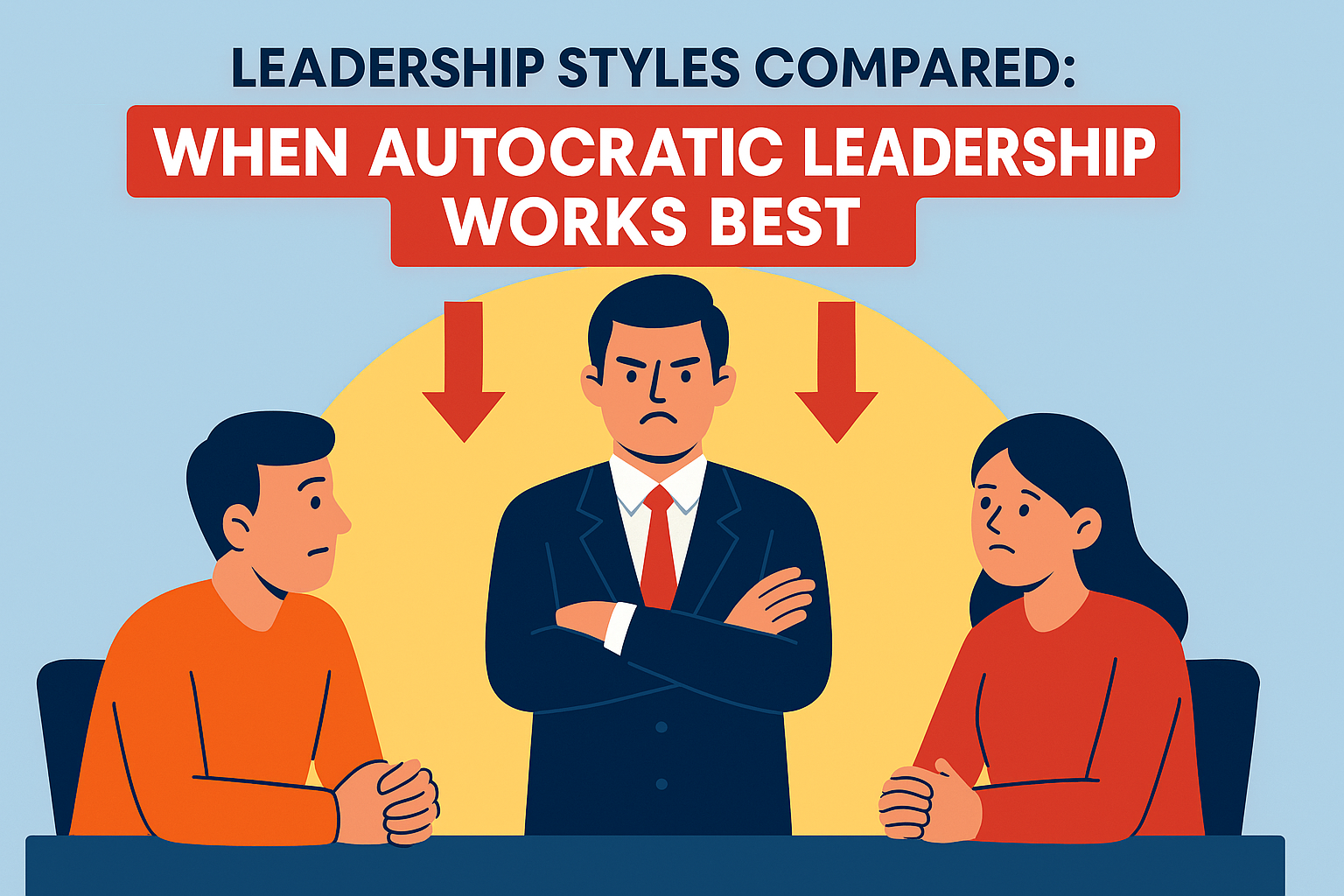Autocratic leadership often gets a bad rap. You hear about micromanagement, lack of team input, or even potential morale issues.
Yet, there are situations where this top-down approach can be the most efficient, even the most logical, way to steer a team.
This post explores where autocratic leadership stands compared to other styles, how it can work in your favor, and why it’s not automatically a negative. You’ll learn how to make autocratic leadership an asset when speed, clarity, and decisive decision-making are at a premium. Let’s dig in!

Understanding Autocratic Leadership in the Bigger Picture
Your leadership approach shapes the way you communicate expectations, set goals, and handle challenges.
Whether you tend to go for democratic methods or lean toward a laissez-faire style, autocratic leadership stands out because it puts you in the driver’s seat, unequivocally.
You set the vision, the rules, and the exact plan of execution—no second-guessing from the team.
But it’s not as simple as barking orders. Think of it like being the pilot of a plane.
You have a mission, strict timelines, and a chain of command. Everyone wants a say, but in a moment of crisis, you need someone who can take quick, decisive action.
Autocratic leadership ensures that the chain of command is straightforward, responsibilities are unambiguous, and tasks get done without needless debate.
Many confuse autocratic leadership with just being bossy. Sure, you have the final word, but effective autocratic leaders listen to their teams in a preliminary phase.
They gather relevant input from stakeholders and experts. Then, once it’s time to decide, they shift gears from consensus mode to authoritative mode. The result? A quick, clear-cut decision that keeps projects on schedule.

Common Misconceptions about Autocratic Leadership
Before diving into why autocratic leadership can be a smart choice in certain situations, it’s helpful to dispel a few myths.
One of the biggest misconceptions is that autocratic leaders don’t care about their team’s input. In reality, strong autocratic leaders gather intel; they just don’t subject every decision to a majority vote.
Another misconception is that autocratic leadership suppresses innovation.
This style indeed places checks on when and how ideas are incorporated—namely, before a final decision is made by one authority figure.
But once you establish a clear direction, your team can still innovate within those parameters. Like a conductor setting the tempo, you ensure everyone is playing the same tune but can still add their unique flair.
You might also encounter the notion that autocratic leadership breeds low morale.
While morale can dip if team members feel completely sidelined, the real problem is typically a lack of communication and respect.
Autocratic leadership doesn’t mean you skip positive feedback, recognition, or transparent discussions. You still offer guidance, but you reserve the final call for yourself.
When Autocratic Leadership Fits Best
If you work in an industry or environment that relies heavily on compliance and strict regulations—think healthcare, finance, military, or emergency services—autocratic leadership can be invaluable.
When errors can have severe consequences, a clear chain of command and immediate decision-making help reduce risks and confusion.
Time-sensitive projects also benefit from a more directive style. If you need to deliver a product or complete a campaign in record time, consensus-building can slow you down.
You want your team to have a chance to offer relevant feedback, but you can’t afford to wade through endless debates. A firm “Let’s do this” can keep everyone on track.
Autocratic leadership can also shine when your team includes brand-new employees.
When you’re training beginners, you’re more likely to use a teaching approach that’s instructional.
Newcomers often require step-by-step instructions, and that can look a lot like an autocratic style—one or two voices guide the rest until they’re confident.

Potential Pitfalls and How to Avoid Them
There are certainly risks if you don’t handle autocratic leadership with care.
One potential pitfall is a drop in employee engagement. If team members feel they’re never heard, you might lose their best ideas—or worse, they may become resentful and disengaged.
You can avoid this by encouraging regular feedback sessions, especially in the planning stages of a project.
Focus these sessions on gathering insights, clarifying details, and brainstorming solutions. Make it clear you have final say but appreciate their input. This kind of environment can keep your team feeling valued.
Another pitfall is burnout—both yours and your team’s. When you are the sole decision-maker, you carry all the stress of major calls.
Balancing the pressure requires recognizing when it’s best to hand off certain tasks. An effective autocratic leader still delegates, even if the ultimate responsibility rests on one set of shoulders.
Hand over smaller decisions to trustworthy team members while you maintain control over the strategic vision.
Building Trust as an Autocratic Leader
Trust might seem like a challenge when decisions flow from the top, but you can foster a supportive environment by maintaining clear communication.
Let your team know why you’ve decided on a particular course of action. Share the rationale behind deadlines, resource allocations, and the metrics for success.
Frequent one-on-one check-ins help, too. They can be short, but they convey you’re paying attention to each team member’s concerns, challenges, and accomplishments.
This approach shows your team that even though you’re the primary decision-maker, you’re not ignoring the realities on the ground.

Comparing Autocratic with Other Leadership Styles
To truly understand where autocratic leadership excels, consider how it stands alongside other popular styles:
- Democratic Leadership: This approach is highly collaborative and values the team’s input. It thrives in organizations that can afford the time to let everyone weigh in. However, it can bog you down when decisions are time-sensitive or the stakes are extremely high.
- Laissez-Faire Leadership: A hands-off style that gives your team ample autonomy. It nurtures creativity but can lead to confusion if roles aren’t clear. It’s generally not ideal when stringent compliance or critical deadlines define your environment.
- Transformational Leadership: Leaders who inspire and motivate through a vision. While highly engaging, it can be less effective when immediate decision-making is crucial. Transformational leaders excel in larger strategic initiatives, but autocratic leaders might step up for more time-pressured tasks.
- Servant Leadership: Focuses on meeting the needs of the team first. This style fosters loyalty and strong relationships but may not offer the quick command response needed in emergencies or highly regulated sectors.
Autocratic leadership wins out in environments where consistency, rapid decisions, and clarity are critical. If those factors align with your current organizational or project demands, you might find that an autocratic approach aligns surprisingly well.
Autocratic Leadership in Real-World Scenarios
Envision you’re leading a product rollout that has to happen before the holiday season.
Every day counts.
Any delay means your company could miss crucial sales opportunities. In a democratic setup, you’d spend days debating the marketing message, color scheme, or final product features.
There’s merit to collaboration, but if the clock is ticking, a single decisive voice can keep the machine moving at a steady clip.
Similarly, in an emergency services context—whether it’s a hospital or a disaster relief operation—someone has to call the shots, often instantly.
Having a designated leader who can synthesize available data and quickly make life-or-death decisions is not just beneficial; it’s essential.
Even in creative settings, an autocratic leader can help unify a vision when dealing with a large, fragmented team. Consider a film set.
While collaboration among writers, set designers, and actors is vital early on, the director often embodies a form of autocratic leadership to ensure the final product aligns with a singular vision.

Leveraging Technology to Support Autocratic Leadership
If you’re inclined toward autocratic leadership, or you find yourself in situations where it’s necessary, technology can be a game-changer.
Tools that offer real-time task management, analytics dashboards, and instant communication channels help you maintain visibility without micromanaging each person.
You can issue directives clearly, track progress, and pivot as needed.
For instance, Teamly software is designed to streamline oversight. You see who’s working on what, identify bottlenecks at a glance, and step in immediately if something derails.
That level of quick intervention is where an autocratic style truly shines. With a platform like Teamly, you can make fast decisions based on real data, not just gut instinct.
This ensures your directives come across as informed and relevant, boosting your team’s respect for your leadership.
Technology also helps you stay in constant contact with key players.
Messaging tools, collaborative workspaces, and file-sharing platforms make it simpler to keep everyone aligned while still maintaining that single point of decision-making.
You can gather input asynchronously, then swiftly finalize the route without calling everyone into endless meetings.
Tips for Making Autocratic Leadership Work for You
1. Gather Data and Insights Ahead of Time: Even if you plan to make the final decision, you still want the right data. Reach out to experts on your team, check market research, and gather real-time metrics before you lock in your plan.
2. Communicate the Decision Clearly: After deciding, present your rationale. Include what data or perspectives influenced you. This not only clarifies your direction but also demonstrates respect for your team’s thoughts.
3. Encourage Controlled Input: You might set an initial brainstorming session or feedback window before the decisive moment. Let your team know they have a set time to voice opinions and concerns. Once that time is up, move forward decisively.
4. Delegate Where Possible: Autocratic leadership doesn’t mean doing everything yourself. When you identify tasks that don’t need your immediate sign-off, assign them to capable team members. This frees you to focus on strategic decisions.
5. Offer Regular Recognition: Just because you have the final say doesn’t mean you can’t celebrate achievements. Give your team credit for their contributions, and be generous with gratitude. Recognition builds trust and keeps morale high.
Finding Your Balance
Autocratic leadership isn’t an all-or-nothing proposition.
You may find that certain phases of a project or certain teams respond best to a more authoritative stance, while other stages or different groups thrive under collaborative leadership.
The key is staying flexible and aware of the context. You aim to deploy your leadership style as a strategic asset, not a blanket approach.
A healthy leadership toolkit features a range of styles, each pulled out when it best suits the organization’s needs.
By understanding when and how autocratic leadership can work, you set yourself up for more effective management overall.
Conclusion
Autocratic leadership might be misunderstood, but it has strengths that can’t be overlooked.
It offers clear structure, rapid decision-making, and a way to steer your team through urgent, complex challenges with minimal confusion.
By communicating openly, inviting initial input, and leveraging tools like Teamly, you can harness the benefits of autocratic leadership without turning into a tyrant.
If you want a style that’s laser-focused on efficiency and clarity, autocratic leadership might be the missing piece in your management arsenal.
It’s not always about ruling with an iron fist; it’s about stepping up at the right moment, ensuring everyone knows the plan, and maintaining accountability for results.
Give it a try when the stakes are high or deadlines are tight—you may discover it’s exactly what your team needs to stay on track and succeed.





















































